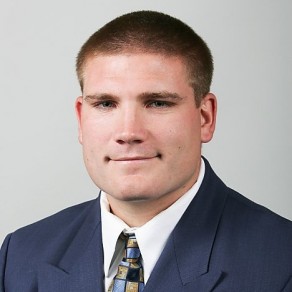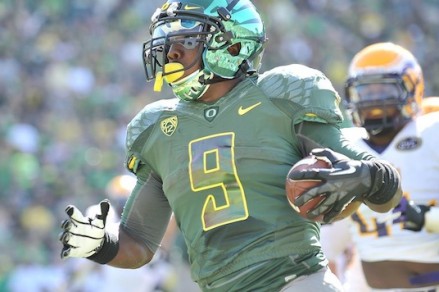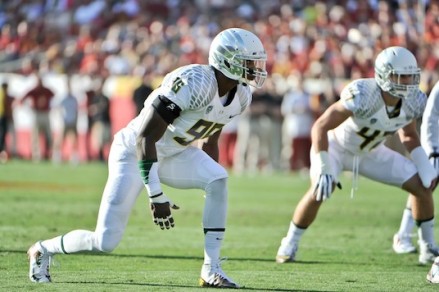This multi-week series will attempt to take a reasonable, logical and unbiased look at Oregon’s recent recruiting successes and failures while analyzing the program’s recruiting philosophy under Chip Kelly. The series will then look at how that philosophy already has and may continue to evolve under Mark Helfrich before ending with a detailed breakdown of the author’s ideal recruiting blueprint.
Part 1: What Happened in 2012-2013
Part 3: What Went Right: The Oregon Brand
Part 6: A Recruiting Blueprint
When it comes to Oregon’s recruiting strategy, nothing is more important than deciding HOW to recruit. Evaluating talent and character is one thing, but how should coaches proceed once they’ve identified targets?
Any recruiting blueprint is incomplete without looking at the social component, which is too often overlooked. Look no further than Tosh Lupoi, a name that isn’t too popular in Oregon recruiting circles. Lupoi gets paid more than $400,000 per year from the University of Washington. You would think that an assistant coach making that kind of money would be a proven developer of talent, a guy who has a history of on-field success who has taught many NFL players. Whether or not Tosh Lupoi is a great defensive line coach is irrelevant, however. The fact is, he does not have the kind of coaching track record to warrant his nearly half-million dollar salary as a position coach. Lupoi gets paid because he’s a great recruiter, and he’s a great recruiter because he has mastered the social aspect of the recruiting process.
The blue bloods of football – schools like Alabama, Michigan, Ohio St., and USC – have a lot more leeway than everyone else when it comes to recruiting. Having a long tradition of success and being located in a talent-rich region is a great combination. For those blue blood schools, the recipe for success is nearly complete before any other ingredients are added. For everyone else, there is significantly less room for error. For those less fortunate programs (the majority of the college football world) there is no more significant factor than having strong relationships with recruits themselves. Relationships play a crucial role in guiding a prospect to one school over another. Almost any recruit you ask will say that they want to be a part of a “family environment”. Nothing makes a recruit more comfortable than having a strong relationship with one of the coaches. This is why Tosh Lupoi gets paid $416,000 per year: there might not be a more effective relationship-building recruiter out there.
*Let’s stop for a minute. If this isn’t adding up, remember that it’s a lot easier to coach up elite players than average ones. Recruiting rankings aren’t perfect, but as a whole, they do a great job of evaluating high-school players. Thus, some schools definitely believe it’s ok to have a so-so coach as long as he’s an ace recruiter. Not all schools abide by this philosophy, however, and would rather employ great coaches who aren’t good recruiters. Obviously, everyone wants both, but often times schools are forced to pick: ace recruiter or proven coach?
So what makes Tosh Lupoi so good at building strong relationships with elite high school athletes? Well, it starts with the fact that he’s younger than most position coaches, making it easier for him to relate to 17-year-olds. He also seems to be an extremely charismatic, personable guy. People are naturally drawn to him. He’s probably just one of those guys that everyone likes. Not every coach (very few, actually) can have this quality, and because it’s an intangible it cannot be quantified or taught. That’s ok, though, because it’s not the primary reason that Tosh Lupoi is such a good recruiter. The reason he is so good is effort.
The best recruiters are tireless workers. Building and maintaining relationships with a large number of people is extremely difficult work. It’s also necessary in the recruiting world. The more recruits you’ve established a relationship with, the more recruits will ultimately come play for you. A 20% success rate (which is really high) recruiting 20 players is a heck of a lot better than a 20% success rate recruiting 10. Unfortunately, actively and consistently recruiting 20 players is twice as much work. This presents logistical challenges, which we’ll look at next week. Bottom line: being a good recruiter requires working your tail off.
In the first part of this recruiting blueprint I said that once players are evaluated, and a list of targets has been identified, those targets should be aggressively pursued. This means working extremely hard to build a relationship. The player’s position coach should be heavily involved in his recruitment. Weekly calls are a requirement. A barrage of texts and letters isn’t necessary, but just to keep up with the Jones’ means establishing weekly contact. Recruits should feel wanted and pursued. Telling them “we want you” – and then leaving it at that while other top programs keep reminding them how valuable they are — has foreseeable consequences.
Now, I’m not advocating that coaches tickle the ears of recruits and tell them exactly what they want to hear; but rather, asking that an honest relationship is built over an extended period of time. If a player is hearing from a coach weekly, he knows that he’s wanted, even if the coach doesn’t continue telling him. In fact, building an honest relationship that goes beyond football has proven really beneficial; if a prospect understands that they’re valued for more than just their football talent, they are much more likely to be comfortable with and even sentimental about the relationship. Often times, a prospect will detail his commitment by citing a strong father-figure-like or brotherly bond with his recruiter. This isn’t by accident, and it didn’t happen because the recruiter called once a month to talk about football.
Next week, we’ll look at the logistics of this recruiting blueprint. Building strong relationships with all of your targets sounds great, but is it possible? What is the time commitment? The purpose of this part of the blueprint was to establish the importance of strong relationships between recruiter and prospect. It’s crucial to ultimately landing a commitment. Additionally, Tosh Lupoi was used as an example of someone who has risen to the top of the recruiting ranks thanks, in large part, to a tireless work ethic that is shared with other renowned recruiters. This blueprint requires Oregon coaches to put in a significant amount of time and energy into the relationship-building process because there is no other factor more important to Oregon’s recruiting success, since the program doesn’t have a long history of producing NFL talent and is not located near a talent-rich region.
Related Articles:
Chip Kelly Update: Everything's Good Again ...
Chip Kelly Update: Wailing and Gnashing of Teeth
Shock and Awe -- The Oregon Ducks' Football Hangover Effect
Despite Lopsided Score, Georgia State "Never Stopped Believing"
Hope Springs Eternal for Ducks
Incompetent Pac-12 Officials: How Do You Miss ALL of THIS?
Chris was born in Montevideo, Uruguay, but made his way to Oregon by the age of five, when he attended his first game at Autzen Stadium. A huge sports fan at a young age, Chris grew up playing football, basketball and golf. Although realizing he isn’t likely to play in the NFL or NBA, Chris still holds on to hopes of being a professional golfer should his unfortunate putting woes take a turn for the better. A bit of a platypus, he attended both Oregon State and Oregon during his collegiate days where he earned a business degree in Finance and Business Administration. Chris works for Daimler Trucks North America in Portland, and plans to get his MBA from the University of Oregon.
Chris has been an active member in the recruiting community since 2005. He studies the intricacies of recruiting and is particularly intrigued by talent evaluation techniques. He is currently working on developing his own scouting reports for every scholarship player on the UO roster. Chris lives with his wife, Katrina, and his two-year-old son Lucas (a future dual-threat QB).





